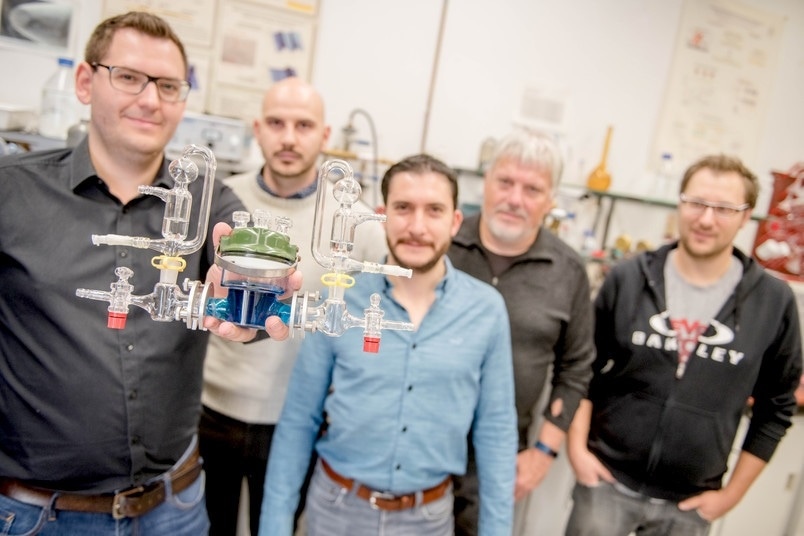Nov 15 2018
Technically, fuel cells that function with the hydrogenase enzyme are equally efficient as those that contain platinum—a costly precious metal—as a catalyst. Conversely, the enzymes require an aqueous environment, which makes it rather difficult for hydrogen—the starting material for the reaction—to reach the electrode loaded with enzymes.
 The Bochum research team: Julian Szczesny, Nikola Marković, Felipe Conzuelo, Wolfgang Schuhmann and Adrian Ruff (from left). (Image credit: RUB, Marquard)
The Bochum research team: Julian Szczesny, Nikola Marković, Felipe Conzuelo, Wolfgang Schuhmann and Adrian Ruff (from left). (Image credit: RUB, Marquard)
Now, scientists have resolved this problem by integrating a gas diffusion electrode technology with the previously developed strategies for packaging the enzymes. The system designed in this way was shown to achieve considerably higher current densities than formerly realized with hydrogenase fuel cells.
The study has been reported in the journal Nature Communications, in which researchers from the Center for Electrochemical Sciences at Ruhr-Universität Bochum, along with coworkers from the Max Planck Institute for Chemical Energy Conversion in Mülheim an der Ruhr and the University of Lisbon, have described how they designed and tested the electrodes. The article was published on November 9th, 2018.
Advantages and disadvantages of gas diffusion electrodes
Gas diffusion electrodes have one major advantage—they can efficiently transport gaseous raw materials meant for a chemical reaction to the surface of the electrode with the catalyst. While gas diffusion electrodes have already been tested in many different systems, the catalyst was electrically wired directly to the surface of the electrode.
“In this type of system, only a single layer of enzyme can be applied to the electrode, which limits the flow of current,” states Bochum chemist Dr Adrian Ruff, describing a drawback. In addition, the enzymes were not shielded from the effects of harmful environment. However, in the hydrogenase case, this is essential because this enzyme is not stable when oxygen is present.
Redox polymer as an oxygen protection shield
In the recent past, the chemists from the Center for Electrochemical Sciences in Bochum were able to create a redox polymer in which they can insert the hydrogenases and shield them from oxygen. However, earlier, they had merely tested this polymer matrix on flat electrodes and not on porous three-dimensional (3D) structures like those used in gas diffusion electrodes.
The porous structures offer a large surface area and thus enable a high enzyme load. But it was not clear whether the oxygen protection shield on these structures would work and whether the system would then still be gas-permeable.
Dr. Wolfgang Schuhmann, Professor and Head, Center for Electrochemical Sciences, Ruhr-Universität Bochum.
Applying enzymes to electrodes
One major issue with the manufacturing process is that the electrodes are hydrophobic, that is, they repel water, while the enzymes are hydrophilic in nature, that is, water-friendly. Therefore, both surfaces are likely to repel one another. Based on this reason, the scientists initially applied an adhesive yet electron-transferring layer to the surface of the electrode, onto which they subsequently applied the polymer matrix with the enzyme in the next step.
We specifically synthesised a polymer matrix with an optimal balance of hydrophilic and hydrophobic properties. This was the only way to achieve stable films with good catalyst loading.
Dr Adrian Ruff, Center for Electrochemical Sciences, Ruhr-Universität Bochum.
The electrodes designed in this manner were found to be still permeable to gas. Furthermore, the tests demonstrated that for porous 3D electrodes, the polymer matrix also works as an oxygen shield. With the help of the system, the researchers obtained a current density of eight milliamperes per square centimeter, but previous bioanodes with hydrogenase and polymer only reached one milliampere per square centimeter.
Functional biofuel cell
The team integrated the aforementioned bioanode with a biocathode and demonstrated that a functional fuel cell can indeed be developed in this manner. The fuel cell was able to achieve an open circuit voltage of 1.13 V, which is merely less than the theoretical maximum of 1.23 V, and a power density of up to 3.6 mW/cm2.